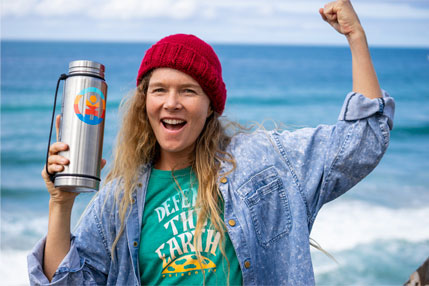
Mangrove Forests—A Powerful Solution to Climate Change
CauseMangrove Forests—A Powerful Solution to Climate Change
Today, July 26, 2021, is International Mangrove Day (or as the UN officially calls it, International Day for the Conservation of the Mangrove Ecosystem), and if ever there were a plant that deserved a worldwide day of recognition, the mangrove is it.
Though they are found in tropical climates all over the world, in total mangroves only cover an area of land equivalent to about 3% of the Amazon rainforest. Yet mangrove trees and shrubs can sequester four times the amount of carbon that rainforests can. In fact, in the year 2000, mangroves held about 6.4 billion metric tons of carbon in their soil.

Planting baby mangroves like this one in Indonesia is crucial to restoring deforested populations. Photo: SeaTrees
This is a big deal at a time when human-created greenhouse gas emissions have caused the planet’s climate to change drastically, leading to devastating and more frequent storms, wildfires, flooding, ocean acidification and sea level rise. Greenhouse gas emissions have already caused the planet to warm by about 1.2 degrees Celsius, and the United Nations estimates that that figure could rise to 1.5 degrees by 2030, a number that could result in irreversible fallout from climate change.
To prevent this from happening, the world needs to reduce emissions by 6% per year every year between 2020 to 2030. But the world is only currently reducing at about a rate of 2% per year, putting us on track to far exceed that 1.5-degree warming milestone.
For this reason, it’s now necessary for the world to not only reduce emissions, but to take carbon dioxide out of the atmosphere. “We will pass a tipping point that we can’t come back from unless we do both at the same time,” says Michael Stewart, co-founder of the non-profit Sustainable Surf.

Sustainable Surf Co-Founder Michael Stewart with the local team from Eden Projects, who are managing the reforestation efforts on Biak Island. Photo: SeaTrees
Kindhumans partners with Sustainable Surf through our 3% Giveback program, where upon checkout from our store, you choose a cause to contribute a portion of the proceeds of your purchase. If you select the “Planet” option, your contribution goes to SeaTrees, a program under Sustainable Surf that restores critical coastal ecosystems around the world, including mangrove populations.
Through these efforts, millions of mangroves are being replanted where they were previously lost to deforestation or natural disasters, exponentially increasing the ability of the global mangrove population to sequester carbon dioxide from the atmosphere.
Capturing carbon isn’t a mangrove’s only superpower, though. Their deep and dense root structure helps prevent coastal flooding and erosion, serves as a nursery for fish and habitat for other wildlife, and filters pollutants from the water. All of these functions help coastal communities, which rely on mangroves for protection from natural disasters, as a food source, and as an economic engine.
“In the last 50 years we’ve wiped out about 50% of the mangrove forests around the world,” says Stewart. “They are some of the biggest carbon sinks on the planet, and they’re also economic and biodiversity powerhouses. There’s this holistic thing of, carbon is important, but it’s one of like five amazing things that restoring these ecosystems actually does.”
 Long-term mangrove restoration projects provide income for villagers as well as restore the forests on which they rely for fishing and coastal protection. Photo: SeaTrees.
Long-term mangrove restoration projects provide income for villagers as well as restore the forests on which they rely for fishing and coastal protection. Photo: SeaTrees.
SeaTrees has mangrove restoration projects in the Biak Island region of Indonesia, and in the Mida Creek watershed of Watamu, Kenya. In Indonesia, they’ve partnered with a local nonprofit to provide villagers on the islands employment through the mangrove restoration project, planting seedlings, monitoring growth and degradation and protecting restored areas. Prior to SeaTrees’ involvement, Biak Island’s mangrove estuaries had been deforested by about 75%, mainly due to natural disasters. By the end of 2021, the SeaTrees project in Indonesia will have planted about 700,000 mangroves in the region.
 When the SeaTrees program began on Biak Island, 75% of the mangrove population had been destroyed. Photo: SeaTrees
When the SeaTrees program began on Biak Island, 75% of the mangrove population had been destroyed. Photo: SeaTrees
In Kenya’s Mida Creek, mangrove degradation is mostly due to deforestation, as the trees are illegally cut down for lumber and charcoal. Not only does this threaten the biodiversity and coastal resilience of the area, but it jeopardizes the local population’s ability to earn needed income from ecotourism.
 Thriving biodiversity is key to building an ecotourism economy, but without mangroves, wildlife cannot thrive in these ecosystems. Photo: SeaTrees
Thriving biodiversity is key to building an ecotourism economy, but without mangroves, wildlife cannot thrive in these ecosystems. Photo: SeaTrees
SeaTrees’ local partner there has set up a network across about 13 villages in the Mida Creek region, through which villagers are compensated for growing mangrove seedlings in their own nurseries to be planted in estuaries once they have matured. The program also addresses the root cause of the deforestation, by establishing areas where fast-growth trees can be grown and harvested in lieu of mangroves.
 The SeaTrees program in Kenya provides work opportunities for individuals across roughly 13 villages in the Mida Creek watershed, in collaboration with local partner COBEC. Photo: SeaTrees
The SeaTrees program in Kenya provides work opportunities for individuals across roughly 13 villages in the Mida Creek watershed, in collaboration with local partner COBEC. Photo: SeaTrees
SeaTrees raises money for these projects through giveback programs like the one with Kindhumans, as well as through SeaTrees “Tokens” sold on their website. The Tokens allow you to “wipe out” the impact of some of your carbon-emitting activities, like flying, driving, or buying a new surfboard, by contributing to these coastal ecosystem projects in rough equivalency to the amount of carbon dioxide your activity emitted.
While mangrove forests aren’t the only coastal ecosystems that SeaTrees supports – it also sponsors kelp restoration in California, an entire “ridge to reef” watershed restoration project in Cambodia, and coral restoration in Indonesia – the carbon storing ability of mangroves make them truly exceptional.
The rewards – for the planet, its people and its wildlife – of restoring mangroves are game changing. The risks – of not protecting them and letting millions of tons of additional CO2 release into the atmosphere – are critical. So on International Mangrove Day, consider contributing to coastal restoration through our giveback program, or by purchasing SeaTrees tokens that wipe out some of your environmental impact. In storing carbon, protecting coastlines and supporting biodiversity, mangroves work hard for the planet every day, and today is a great day to show our appreciation.










